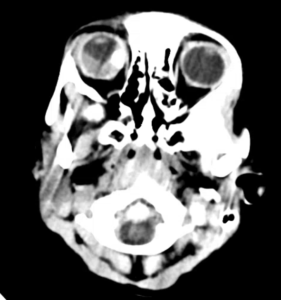Hot Seat #75: unvaccinated female w/ photophobia and ptosis
Posted on: May 23, 2016, by : Evan Sherman
Evan Sherman, Children’s National Medical Center
with Shilpa Patel, Children’s National Medical Center
The Case
5yo otherwise healthy, unvaccinated female presents with progressive photophobia, ptosis, and redness of the right eye for 4 weeks. Her parents first noted symptoms 4 weeks ago, when the eye looked a little “cloudy, like she was wearing a colored contact” but she was otherwise well. Over the last 2 weeks she has had worsening swelling around the right eye, drooping of the right eyelid, and some redness of the right eye. She has also been tilting her head to the left.
She was seen at the PMD today, where a CBC and BMP were drawn and reportedly normal. She was referred to the ED due to these concerning symptoms.
ROS: No trauma to the eye, fevers, chills, night sweats, weight loss, gait abnormalities.
PMH: None. Unvaccinated.
PSH: None
Meds: None
Allergies: NKA
FHx: No glaucoma or other eye diseases
SHx: Home schooled, lives with mom, dad, and 5 other siblings. Has an older sibling with autism; parents decided not to vaccinate younger siblings.
PE: VSS
General: Alert. Appropriate for age. Cooperative.
Eye: Left eye with mild ptosis, EOMI. Right eye with ptosis, gaze resting down and out, unable to move eye farther superiorly or medially. Right conjunctiva appears injected but no discharge, with mild erythema of surrounding skin. Her left pupil is 4mm and reactive; her right pupil is 4mm and unreactive. Fundoscopic exam attempted but patient is unable to cooperate. Vision is 20/30 left eye, no light perception in right eye.
Neurological: Seems to prefer to tilt head to left, but able to move head without difficulty. Aside from this finding and the eye exam described above, patient has a normal and nonfocal neurologic exam.
Exam otherwise normal.
The patient’s father is polite, but admits to having some distrust of doctors and is very reluctant to perform any testing. After an extensive conversation with the father, you agree to start the workup with a noncontrast head CT and an ophthalmology consult. The CT shows no intracranial pathology, but does show the following:
Ophthalmology examines the patient. They find retinal detachment of the right eye and elevated IOP, and they confirm your visual acuity exam. Their differential is broad and includes infectious, inflammatory, and neoplastic etiologies. They recommend bloodwork, urgent follow up with a retinal specialist, and an MRI brain. They defer decision regarding admission to the ED team. The retinal specialist can see the patient tomorrow if they are admitted, or later this week if they are discharged home.
Question for you:
You discuss the results of your workup with the father, as well as with the mother via phone. They remain polite and ask many questions. They refuse any bloodwork and state that they do not want to be admitted. You urge the parents to agree to admission for an expedited workup, but they refuse.
A few other questions:
How would you approach this case? Please share your opinions by clicking on “What do you think?” below.
The information in these cases has been changed to protect patient identity and confidentiality. The images are only provided for educational purposes and members agree not to download them, share them, or otherwise use them for any other purpose.


Wow, this is a loaded case. There’s a lot of ways to approach this from the teaching perspective meaning so many directions we could go. I’ll work off the beaten path and just raise awareness of meeting families where they are, despite being a busy ED, taking a few (or many more) minutes to explore the past (in this case, distrust of doctors – it may be based on one incorrect fact that they are willing to let go of (sometimes)), and unfortunately, I will say sometimes prognosticating on what will actually change depending on whether the parents do or don’t do what you thin is medically indicated.
Just this weekend, while working I received a call about a hand burn. Our standard path is transfer here, have burn see it, and so on. Realistically, a few digits with partial thickness burn….may just heal fine with some good wound care. Some of what we do in medicine is really quite prophylactic for the small percent of bad outcomes, and that’s where the challenging thing called judgment comes in. It really gets to art of medicine and the wide variation in practice that can so frustrate our trainees (fellows, residents and students alike) and staff (nurses, techs, social workers alike).
Related to this concept is the living in the gray concept and accepting that we don’t always know the answer, or rather have to immediately find out the answer, even when it’s just a test or two, or a consultant or two away. This “capacity to accept ambiguity” (like that ACGME 🙂 is a real challenge and even harder to assess and know do you have it or not. Interestingly, this also can directly relate to the judgment discussion above and it is what makes medicine such a challenging field to practice.
Sorry if this wasn’t the usual banter on the great differential diagnosis retinal detachment can unload, but hopefully the likes of Dave, Dewesh, Brad or Shilpa can jump in on the equally challenging and unique medical aspects of this case.
So I pretty much think everyone should be managed as an outpatient……or at least almost everybody. But I would admit this kid. Although I wouldn’t force it if it was against the family’s wishes.
I think to have an outpatient plan, there needs to be some idea of what’s going on or at least a few next steps and general direction with things pending. But that isn’t the case here. Retinal specialist follow-up is not sufficient. And since this kid is going to need a sedated MRI of the brain, I would advocate on the kids’ behalf to do it now and that would likely dictate some of the next steps depending what’s going on in the orbit behind the globe. Usually with reason and non-threatening language, you can reason with almost anybody and I think the parents would agree if there was a finite endpoint with an inpatient stay.
I have to admit, the exam and findings don’t make much sense. If the eye looks “cloudy” that’s a corneal problem or anterior chamber problem which should have nothing to do with the posterior segment (correct me if I’m wrong here). And not sure why a retinal problem would have anything to do with ptosis. So there is clearly more going on here than non-traumatic retinal detachment, with involvement inside and outside the globe.
When things don’t add up, think conversion disorder or cancer. I’m begrudgingly betting on the latter.
I agree with Pavan, this is a loaded case (and a short turn-around – 4 days from post to denouement). I also agree with Dave, I’m not sure I could send this child home.
So here it goes….better late than never ☺
From the medical standpoint:
This child has the findings consistent with a oculomotor (CNIII) nerve palsy in the right ‘red’ eye. The third cranial nerve innervates the levator muscle (eyelid), four extraocular muscles (medial rectus, superior rectus, inferior rectus and inferior oblique) and is also responsible to for pupillary constriction. For our patient this is resulting in ptosis, outward and downward gaze (due to unopposed action) and a nonreactive pupil. This is consistent with a complete CN III palsy.
When we consider a differential diagnosis for CN III palsy it goes somewhat along the DDx given by the ophthalmologist:
Neoplasm along it’s path or in the orbit – Retinoblastoma being most common in this age group – also the finding of the ‘red’ irritated eye and CT negative for intracranial pathology support an orbital lesion
Infection (though no headache, fever or meningismus)
Inflammation
Vascular – Aneurysm (no risk factors and uncommon in children)
Cavernous Sinus Thrombosis causing compression of CNIII
Not sure if cloudiness is a presenting sign of retinoblastoma (?late presentation) in addition to what you usually think of (anterior chamber, cornea – glaucoma).
Then considering the ophthalmologists findings of non-traumatic retinal detachment. This is very rare in children and from my reading one should look for a retinoblastoma when retinal detachment (non traumatic) is found in a child. Also when I am looking at the CT, I think there is a ?calcified mass (same as bone) in the vitreous of the right eye – is this retinoblastoma.
I’m not sure her being unimmunized has anything to do with this except for supporting the families mistrust of the medical system.
Finally, one could add myasthenia gravis to the differential however this usually presents with a normal pupillary response (mimics incomplete CNIII palsy) and is unusual at age 5. Though I’m not sure what to make of the left eye with mild ptosis.
Social Issues:
I think perhaps the issue here is the uncertainty in diagnosis. Did the ophthalmologist mention the possibility of outpatient management to the family? If communicated to the parent as an option by the specialist I think it could minimize the level of concern.
Although I agree with Pavan that sometimes we have to meet the parents where they are and work with their insecurities, this child has a very abnormal clinical exam and has been progressing over weeks, with an abnormal CT and as Dave pointed out, no clear diagnosis. I want the CT read. ☺. Therefore I would try to convince the parents to admit their daughter.
We need to understand their fears (regarding admission to the hospital, further work-up, etc.) and address them. We need to find out if they understand the potential downside of delaying care if MRI/outpatient retinal specialist cannot see her in a timely manner.
Also if they trust their pediatrician, we could ask the PMD to convince the parents of admission or at minimum coordinate outpatient follow-up and work-up.
This reminds me of these 8 questions meant to understand cultural differences in understanding disease and treatment. Though not completely relevant here, in general, thinking about these can sometimes help us understand why a parent is choosing to do something different than what we are recommending.
From The Spirit Catches You and You Fall Down, by Anne Fadiman:
1) What do you call the problem?
2) What do you think has caused the problem?
3) Why do you think it started when it did?
4) What do you think the sickness does? How does it work?
5) How severe is the sickness? Will it have a long or short course?
6) What kind of treatment do you think the patient should receive? What are the most important results you hope she receives from this treatment?
7) What are the chief problems the sickness has caused?
8) What do you fear most about the sickness?
Looking forward to the denouement. Good night.